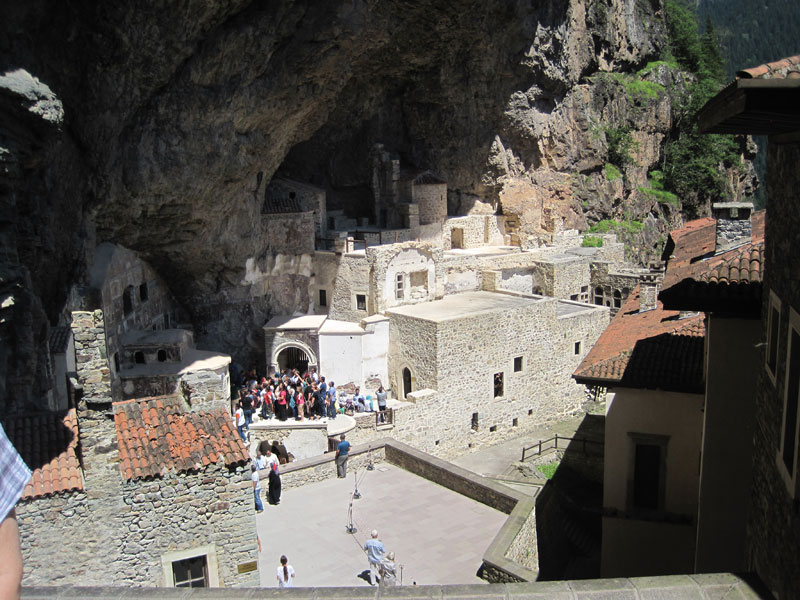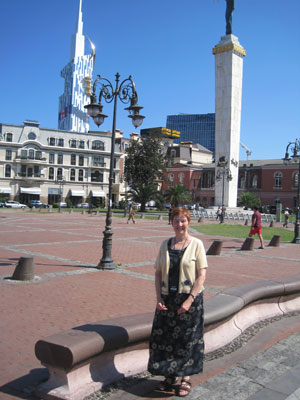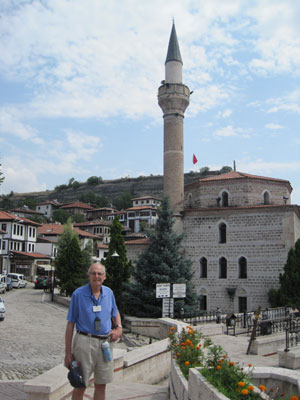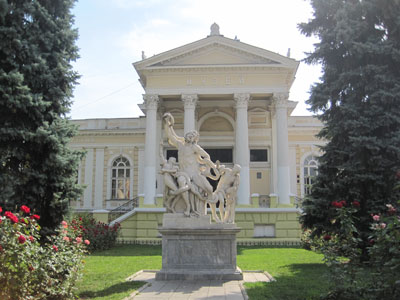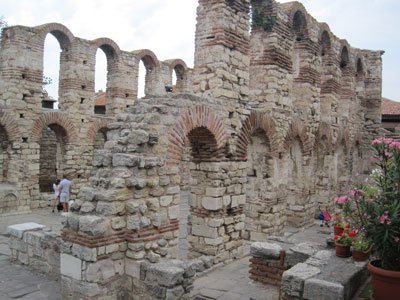A Black Sea cruise during troubled times
This article appears on page 32 of the May 2015 issue.
In May 2014 I received an email with a “two for one” offer for an upcoming 18-day mega-yacht excursion to the six countries that border the Black Sea: Turkey, Georgia, Russia, Ukraine, Romania and Bulgaria. With little possibility of ever coordinating such an ambitious journey on our own, this small-ship tour from Vantage Deluxe World Travel (Boston, MA; 888/514-1845, www.vantagetravel.com) seemed like a good option for my husband, Lynn, and me. The topper? Free air travel from Pittsburgh! I grabbed the phone.
A Vantage salesman patiently answered all of my questions until I blurted, “Is this great deal being offered because folks are backing out due to the current Russia/Ukraine conflict?”
Silence ensued.
“Well…” he finally admitted, “perhaps in some cases. But intrepid travelers such as yourself are filling those empty slots.”
He probably meant cheapskates, but who cared? I booked the package.
Intro to Istanbul
During the next two months, I anxiously followed Internet chatter as others lamented cancellations of their Black Sea cruises by Princess, Holland America and MSC. In June, Vantage notified us that Yalta would no longer be a scheduled stop.
While family and friends questioned our sanity and safety, I fretted that our stop at Odessa, or maybe even the entire cruise, would be canceled.
It was with relief on July 24, 2014, that Lynn and I left for our overnight flight to Istanbul. This was a place I’d never visited and, having eschewed the 3-day Istanbul pre-trip option, we had limited time before and after the cruise to squeeze in my bucket list of sights in the city, so no post-flight nap. Time was wasting!
Leaving our bags at our hotel, the Marmara Taksim, we zipped off to the nearby funicular station for transport to the tram.
Standing in front of the kiosk for tokens, I was perusing our guidebook’s public transportation section when a well-dressed man approached Lynn. He told us he would be happy to assist us; we just had to give him the money to buy our tokens. Lynn trustingly handed over a 20-lira ($7.60) note. The man loaded his personal card with our money, then, after sending us through the turnstile, the scoundrel took off with the extra 14 liras!
Unbelievably, local passersby who heard our cries of outrage chased the man down and held him until transit police arrived. He was forced to return our money while one of the good Samaritans proceeded to apologize profusely, on behalf of her country, for the man’s behavior. We were astonished!
Our impression of Turkey was further burnished when five people got up to offer me a seat on the tram. Imagine seeing that in the USA.
The next several hours were spent visiting Topkapı Palace and Treasury. This gorgeous complex overlooking the Bosporus served as the ruling sultans’ place of residence for over 400 years.
Our final stop was the Blue Mosque, with its massive interior and impressive stained-glass windows.
Returning to the hotel just in time for Vantage’s 6 o’clock orientation, we met our group of 35 other travelers. Lynn and I were amongst the youngest, but we found the others to be a friendly and intrepid bunch who would soldier on despite encountering a heat wave and other “hiccups” over the next 14 days.
It also helped that our trip coordinator and tour guide, Nigar, a personable Turkish woman fluent in English, had an unflappable demeanor.
Pros and cons
In the morning we were given a bus tour of Istanbul before our afternoon embarkation on the M/Y Harmony G.
Despite its sleek appearance and friendly, capable staff, this 53-meter-long, 4-deck mega-yacht proved to have some issues. Each stateroom had a marine toilet, so no toilet paper could be thrown in, ever!
The 22 passenger cabins were spread out over three decks. Unfortunately, those of us on the lowest level discovered that whenever the ship was under way, our portholes were partially underwater, creating a sort of “trapped in a washing machine” feeling.
The staterooms, especially on the bottom deck, were stiflingly hot. We were told the air-conditioning system was running at maximum, but it was a water-cooled system and, unfortunately, the ocean was very warm. Thus, while other passengers shopped for souvenirs in the upcoming ports, Lynn and I searched for an electric fan, an ultimately successful venture that proved to be an enormous help.
On the plus side, the food was good, and the dinner staff kept our wine glasses constantly filled.
Political unrest had significantly dampened tourism in the Black Sea area. After Istanbul, the Harmony G was the only passenger vessel docked at any of the 10 ports we visited.
A group of us got in the habit of meeting after dinner at the top deck’s outdoor conversation pit. With the ship under way, and enjoying the cool breeze and star-filled sky, it seemed like we had the whole Black Sea to ourselves.
Favorite stops
Our daily itinerary usually involved a morning disembarkation followed by a bus trip to featured attractions. Except in Russia, afternoons were free for independent exploration, which allowed ample opportunity to interact with the locals.
We were welcomed everywhere. A woman in Odessa, Ukraine, greeted us with excitement: “You are Americans? What brave tourists!”
A family in Sinop, Turkey, asked us to be in their group photo. Bulgarians in Varna struck up conversations while we swam at their public beach. Folks taking a sea dip in Batumi, Georgia, initiated a series of “group waves” as we sailed past. And at a church in Sulina, Romania, some elderly women insisted we partake of food they had prepared to celebrate a baptism.
What was our favorite port? Beyond question, Odessa. Better yet, with the cancellation of our stop in Yalta, Vantage tacked on an additional night in the city (for a total of three). The locals were thrilled to see us, and even the port’s guard dog was friendly.
Odessa was founded by Catherine the Great, who envisioned a sort of “Paris of the East.” Overlooking the sea, with tree-lined boulevards and parks facing palaces and impressive public buildings, it is a truly beautiful place.
Highlights included Tolstoy Palace, featuring a grand piano said to have been owned by Franz Liszt; Gagarin Palace, where we were served champagne and treated to a private performance by a string quintet from the Odessa National Philharmonic Orchestra; the fabulous opera house, opened just for our group, and Shustov Cognac Museum, serving each of us four generous samples of their famous cognac along with trays of appetizers.
On our own, Lynn and I stumbled onto the Museum of Western & Eastern Art, housed in a beautiful old palace. Their special exhibit of microsculptures was simply amazing!
These tiny but incredibly detailed sculptures could be viewed only through microscopes. My favorite was an entire camel caravan set inside the eye of a needle.
As we were the sole visitors, the staff clustered around us, eager to practice their English skills.
A few surprises
Which port was the most unusual? I would have to say Sochi, Russia, where our morning agenda included a trip to Stalin’s dacha. Now under private ownership, his dacha’s guest wing serves as a hotel.
But here is the really odd part: our Russian tour guide insisted we sit on Stalin’s bullet-proof couch, use his billiard stick to hit some balls and check out his desk set from Chairman Mao. After initial hesitation, our group took advantage of these unique photo opportunities.
And who knew that Russia produces tea? It’s quite tasty, especially when served with homemade bread and jam at a tea plantation located in the hills above Sochi.
Unfortunately, our afternoon visit to Olympic Park proved to be disappointing. Crowded with predominantly Russian/Eastern European tourists, everyone endured a long queue for shuttle transport from the visitor center to the actual park. We couldn’t even purchase Olympic souvenirs, as the only open shop accepted only Russian currency and didn’t take credit cards.
I think Batumi, Georgia, was the most unexpected surprise of all the cities we visited. Since 2010, the government as well as foreign investors have strived to reinvent Batumi into a modern seaside resort, complete with a Ferris wheel overlooking the harbor and offering a panoramic view.
The Old City was razed to create a metropolis of wide boulevards, dancing fountains and futuristic buildings, such as the Alphabet Tower, with its striking DNA helix design, and the imposing, blue-and-white Technological University Tower. An interesting side note — both were unoccupied.
Some older structures still remain. St. Nicholas Orthodox Church, built in 1865 and the only church to survive the Communist regime, is a visual feast and remains an active place of worship.
Just south of Batumi is the old Roman fortress of Gonio where the Apostle Matthew is believed by some to be entombed. Roman baths and first-century-AD water pipelines have been excavated there. This hardscape was offset by a profusion of flowering plants and arbors, the entire complex encircled by the fortress walls.
Afterward we were bused to a nearby establishment for wine, light refreshments and a folk-dance performance by children ages 12 to 15. Expecting the usual tourist experience, our entire group was “blown away” by this troupe. These dancers attended a school where they practiced three hours daily to compete on an international level. It was a fabulous exhibition of talent!
Notable sights
Outside of Istanbul, our vote for the most amazing attraction has to be the Museum of Archaeology in Varna, Bulgaria.
Among its many artifacts housed in three rooms were the world’s oldest gold treasures, discovered in burial sites carbon-dated to 4000 BC. According to our Bulgarian guide, artisans using only primitive tools of shell and stone created these masterpieces of gold jewelry along with medallions to embellish clothing and golden sheaths for weapons.
We really liked Varna. In addition to the museum, it contained a fascinating series of Roman baths. Furthermore, Varna boasted the only beach thus far that we deemed suitable for swimming.
Unlike the rocky shores of Turkey, Georgia and Russia, this one was sandy, clean and within walking distance of our ship. Lynn and I plunged into the sea and found it to be bathtub warm. (No wonder our ship’s air-conditioning floundered.)
Our tour included visits to three UNSECO World Heritage Sites: Nessebar (Bulgaria), Safranbolu (Turkey) and the Danube Delta in Romania.
Nessebar is an ancient city with a plethora of historic buildings (especially churches) dating from Greek occupation through the Byzantine, Bulgarian and Ottoman eras.
Although interesting, its close proximity to Bulgaria’s famed Sunny Beach Resort, as well as the numerous nearby shops geared to tourists, meant the narrow streets were packed with people — not our favorite place (although this attitude may have been influenced by a morning of clogged toilets throughout the ship followed by a stern group lecture about proper waste disposal).
In contrast, possibly because it was the last day of Ramadan, we found Safranbolo to be almost deserted. Famed for the cultivation of saffron, this charming village featured well-preserved Ottoman houses, streets of cobblestone, a historic Turkish bath and a number of mosques.
Our group ate a delicious lunch at the Cinci Han Hotel followed by tea and dessert, all seasoned with saffron.
Our 3-hour boat ride through the Danube Delta was supposed to focus on the wildlife and birds of the region. Unfortunately, our young Romanian guide was no naturalist.
He compensated by giving us an extensive narrative about life in Romania interspersed occasionally with comments such as “See that big white bird” or “I think those may be frogs.” Oh, well. At least we got some insight into current conditions in his country.
A fourth site we visited, Sümela Monastery, is located in the mountains a scenic 40-minute bus ride from the port of Trabzon, Turkey. Currently on UNESCO’s “tentative” list, this monastery was allegedly founded by two Greek monks in AD 385.
The original dwelling was carved into the cliffs and was expanded over the centuries into a 7-story complex featuring amazing frescoes. In a predominantly Muslim country, we were surprised to see so many local visitors, but our guide explained that Sümela is held in high regard by persons of all religious faiths in Turkey. Justifiably so, in my opinion.
On the morning of the 17th day, our ship returned to Istanbul. While the rest of our group headed off for a rug factory and Grand Bazaar tour, Lynn and I bailed. This was my last opportunity in the city and I still had a “must do” agenda.
Before returning to the hotel, we managed to visit the sixth-century underground cistern (eerily beautiful); the New Mosque; Rüstem Pas¸a Mosque, with its dramatic 16th-century Iznik blue tiles, and our absolute favorite, magnificent Hagia Sophia.
The details
For the two of us, the 18-day tour with Vantage Travel, which included everything except gratuities and our last night’s dinner, cost a total of $10,800 — a real bargain for such a diverse and educational experience.
Never did anyone on our tour feel the least bit threatened or uneasy, despite the current political situation. However, throughout the Black Sea countries, people expressed concern for the “Russian problem.” We heard grumblings in Turkey and Georgia about the impact on tourism and saw anti-Putin graffiti in Bulgaria and NATO ships in Romania.
A final bonus — after returning home, we received a letter from Vantage apologizing for the overheated ship and offering us a $1,000 credit on any trip within two years.

